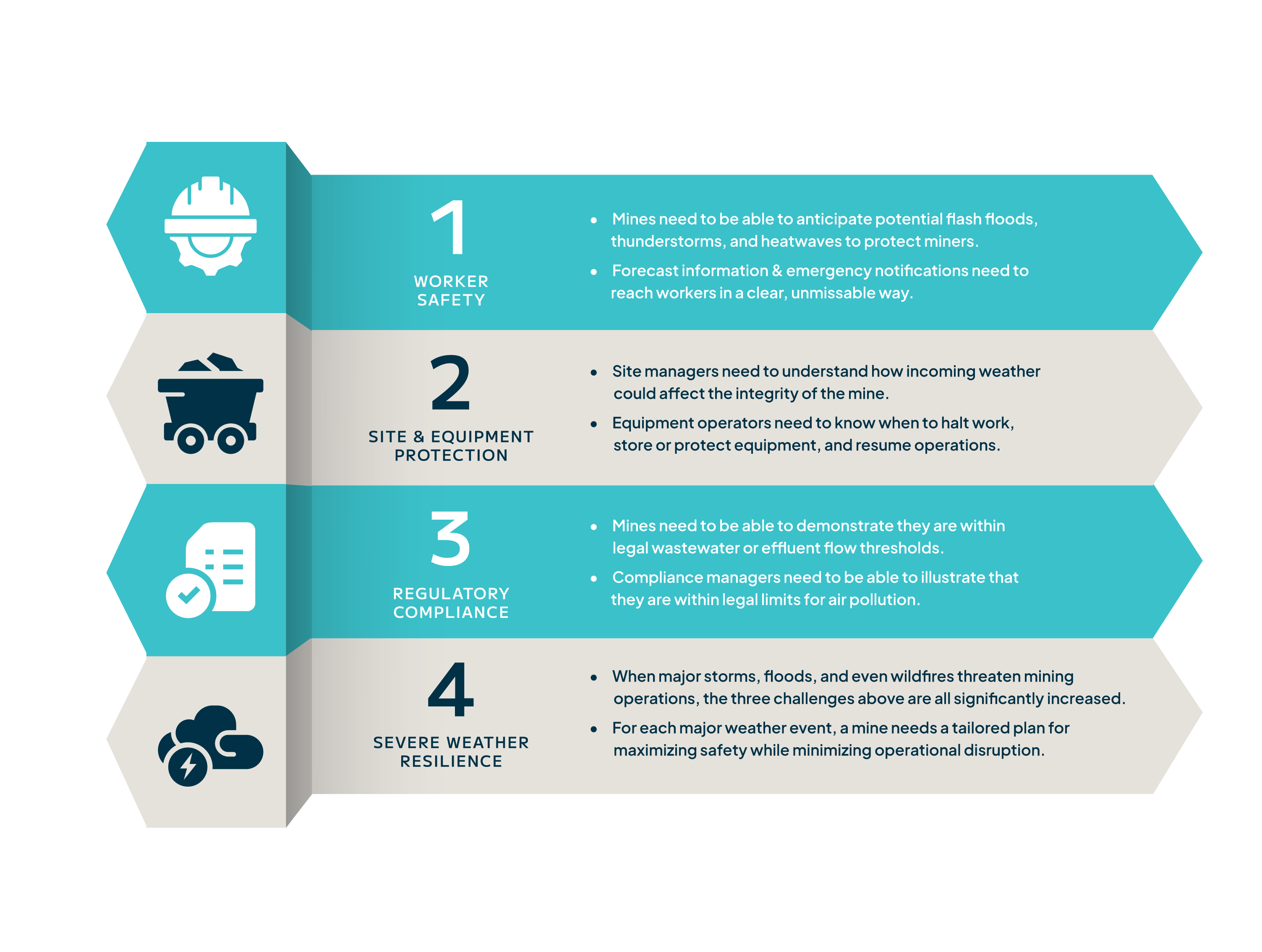
The mining industry is no stranger to the destructive influence of weather conditions on their operations. As climate variability triggers more extreme temperatures and erratic precipitation patterns, it's become imperative for mining companies to not only understand the widening scope of weather-related risks but also develop strategies and adopt new tools to ensure the industry can survive – and thrive – in the face of escalating environmental risks.
Moving forward, we'll explore...
- The growing weather challenges facing mining companies
- How weather intelligence, data, and technology are helping mines approach weather risk better
- How mining companies can level up their strategy to weather resilience
Weather Challenges for mining operations
How high and low temperatures affect mining operations
Mining operations are known to be physically demanding for workers, as they are exposed to various risks and hazards. One of the most significant environmental factors that can impact workers' safety is temperature - both high and low.
When temperatures rise, workers are at risk of heat stress, which can cause serious health issues, including exhaustion and dehydration. On the other hand, low temperatures can lead to frostbite and hypothermia, which can also cause significant harm to workers' health.
Mine operators must ensure that their workers have the necessary equipment, training, and safety protocols in place to mitigate the risks associated with extreme temperatures - but that's not enough. Proactive weather monitoring is essential to prevent the heat stress injuries and illnesses that threaten worker safety and disrupt operations.
How precipitation affects mining operations
Mining operations can be greatly impacted by precipitation, particularly when it comes to flooding and runoff. Heavy rainfall can lead to high levels of water flowing through the mining site, leading to worker safety concerns and potential damage to equipment. To mitigate these risks, flow monitoring is critical in order to quickly identify any changes in water levels.
Additionally, strict regulations and compliance measures are in place to ensure that mining operations are not causing pollution or harming the environment. Protecting the surrounding ecosystem through proper management of rainfall and runoff is essential for a sustainable and profitable mining industry, as is demonstrating that you're doing so in a clearly documented way.
Lightning risks for mines
Mining operations often face a significant threat from lightning strikes, which can cause catastrophic damage to machinery and equipment, as well as pose a severe risk to personnel.
Lightning can also trigger explosions of methane gas inside mines, further emphasizing the need for a comprehensive approach to lightning safety. In some areas, mining operations must stop when lightning is nearby and may only resume work after an all-clear threshold has been reached.
As a result, developing defenses against lightning threats is imperative for the mining industry.
How innovative mining companies are conquering today's weather challenges
Better, more accurate forecasts
Consulting meteorologists have emerged as key resources for mining companies, both at the corporate and individual mine level. Private meteorological service providers can offer a much more powerful, specific forecast than any publicly available source. That's because they're able to focus in on key specific areas (the locations of individual mines, for example) rather than forecasting generally for an entire region.
Working with meteorologists, mining companies are increasing their resilience in the face of all four major challenges explored above. They are able to keep employees and equipment safer, protect their reputation and profits better, and prepare for major weather events more effectively than ever before.
Onsite environmental monitoring
Weather stations and sensors play a variety of important roles in modern mining operations. For one, a local weather station network can significantly increase forecasting capacity for a mining company's meteorologists. That means greater accuracy for short- and long-range predictions and more hyperlocal intelligence about weather patterns and risks in an operation's territory.
Of course, flow and level monitoring sensors, as well as precipitation sensors, are key to output monitoring for compliance. They provide real-time intelligence on drainage and pooling inside and out to demonstrate compliance with environmental and safety regulations. During a major weather event like a hurricane or monsoon, the data from those same sensors can be key to protecting the integrity of the mine, surrounding infrastructure, and workers.
Automated weather alerts & notifications
When it comes to protecting miners, swift, clear communication is essential. While the canary has gone the way of the past, mobile notification and alerting technologies have stepped in to make weather alerts and safety warnings unmissable for workers, regardless of their location or role.
Audible and visible horns, sirens, and strobes provide instantaneous alerts telling workers to seek safety. Mobile notifications can also give role-based updates so each individual worker knows what weather challenge is affecting their work and what they need to do to be part of a safe response.
Talk to a weather risk expert who understands mining
If you're in the mining business and facing a weather challenge (or just looking to proactively take your approach to the next level), AEM is here to help. Our team specializes in helping mines around the world scale empowering solutions to their weather risks and specific situations. We're proud to be a go-to enablement partner for future-facing mines who know the challenges of worker safety and compliance will only get trickier in the face of escalating environmental challenges.
Schedule a conversation today, and we'll begin the process of making your mine truly weather-ready.




